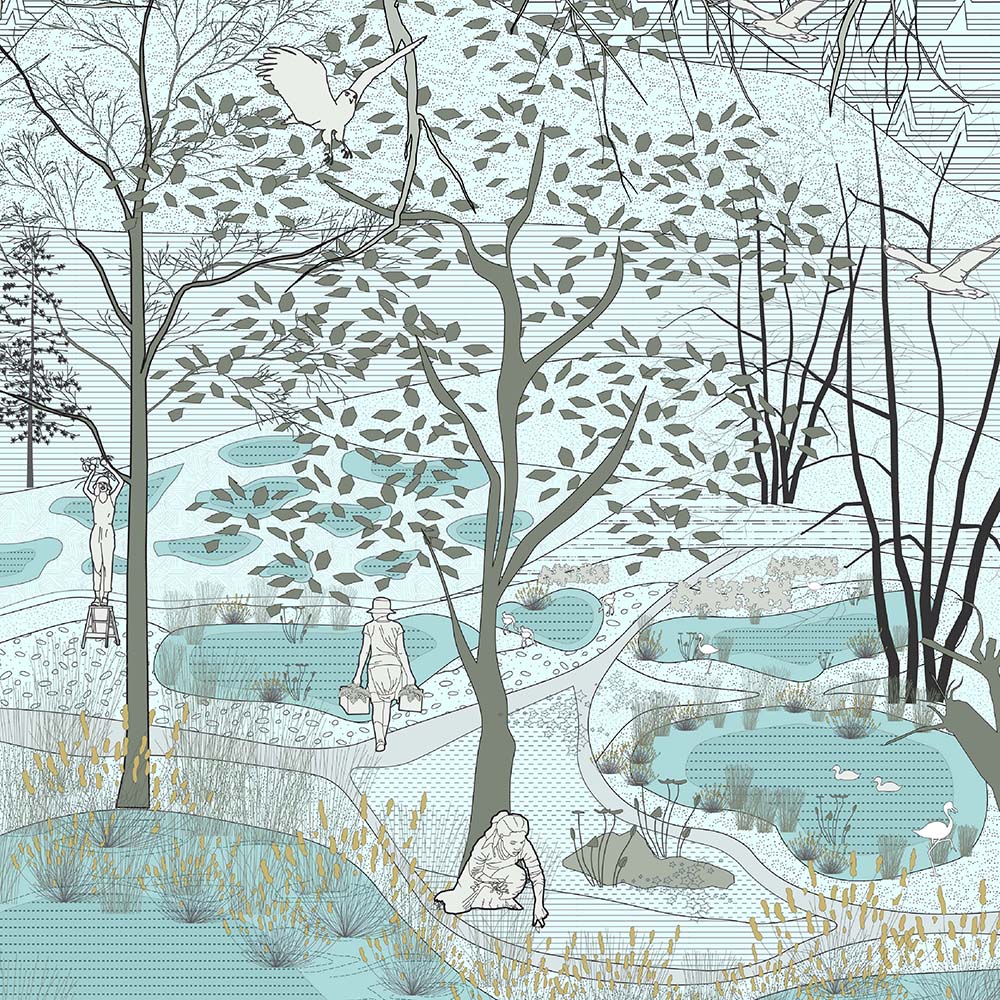The proposal majorly comprises of three parts: orchards & playscapes around water, farms around water, river and the forest and hence it aims to provide three different experiences activities around water. It is expected that the project will increase the groundwater table and facilitate osmosis so that the river can remain full of water during the dry season and continuously feed into the river.
Water-full: Slow, Spread & Seep
-
Tags
Riverfront development, Public space, Ecological design, Water landscape, wetland
by Hariyali Gajera
Project “Water-full” at Gandhinagar city, aims to apply various strategies at the city level to maximize the infiltration of water and recharge groundwater basins. The strategies include street re-design with swales, catchments, and percolation wells on larger lots. The series of strategies will allow for water to slow, spread, and sink.
The same idea is demonstrated and detailed at the main site along the Sabarmati river. There will be a series of connected wetland systems that will clean the city’s greywater and stormwater and allow it to percolate into the ground before it runs off into the river.




Site studies
The groundwater level of the city is going down by 20m each decade With the Sabarmati river dried up, the city has been depending on Narmada Canal for its daily need. Apart from the negligence towards the water as a resource, riverside and river have been ignored by the city over a period of time. As a result of this negligence, the river acts as a back of the city majorly used for dumping religious waste, sand mining, and releasing black / greywater. Apart from being dead in terms of activity & human involvement, the flood plain is infested with the wild and invasive Prosopis julifora, making the site poor in terms of biodiversity.



Concept
After understanding the contour map of the city and overlaying it with the layer of open spaces and existing built fabric, naturally forming, catchments have been proposed to be revived and retained. The other low-lying areas where a catchment condition is not feasible are supposed to be equipped with percolation/recharge wells that will fuel up the infiltration of water in the ground. Wider R.O.W. of the city provides us with an opportunity to have street-side rain gardens & swales of various sizes, beautifying the streets with landscape & minimising the sun-off. The method of the trio- filtration is to be applied to treat the black/grey water and later the treated water can be put to various uses, or at least be released to nearby catchments or at the riverside project. Majorly the public buildings or public use buildings are equipped with rainwater harvesting systems. The harvested water can be channelized either directly into an underground recharged tank or in a neighborhood-level catchment. Apart from all these strategies, the overflow of each of them is channelized to the city’s stormwater drain, which would take the water directly to the site at the riverside at the proposed wetland port for further purification and percolation before reaching the river. The overall proposal aims to utilize the city’s existing water infrastructure & available natural opportunities to maximize water infiltration. The proposal aims to recharge the dried aquifers and increase the water table over a period of certain years as these proposals become come into operation.

Design Development
Coming to the main site of intervention, the proposal here attempts to create a series of interconnected wetland systems that will hold the rainwater and treated stormwater and treated greywater. Alongside creating various experiences and proposing different programs around the proposed water bodies.
Greywater & stormwater or brought to the site via the city’s existing laid network of drains & is treated on-site via the process of trio-filtration in a series & a hierarchy of treatment ponds before releasing them into soft ponds. The soft ponds are all connected, eventually draining its overflow into another pond (channelized by modified contours), which eventually runs off into an artificially created swale (parallel to a natural and adjacent swale) which opens up in the river. This wet system of catchments or the wetland park is the heart of the proposal programmatically as well as geometrically. Artificial modification of contour is applied in order to achieve the desired flow of the water the water garden is then complemented by its surrounding allowed programs like a play area, allotment farms, shrubbery or nursery, and conserved forest cover with meandering trails.
Cutting a transverse section across the site can be visually divided into upland, middle land & low land. The majority of the assigned programs make up the upland, with the heart of the project i.e, the water garden being the middle land. The lower land offers existing swale a few natural catchments and a dramatic slope that terminates into the river. Hence the low land majorly is occupied with meandering trails and pause points for the users to absorb the site experience.





Project’s impact
Other than treating & stopping water, the proposal aims to create an experiential space around the element of water. This way the idea is to make water & systems around it visible to laymen and celebrate the existence and importance of water. Not to forget the health and positive psychological implications of being in such spaces especially after the hectic lifestyles that an urban lifestyle offers.
![Large view [Converted]](https://productiveurbanism.com/storage/2023/05/Large-view-low-res-5.jpg)


